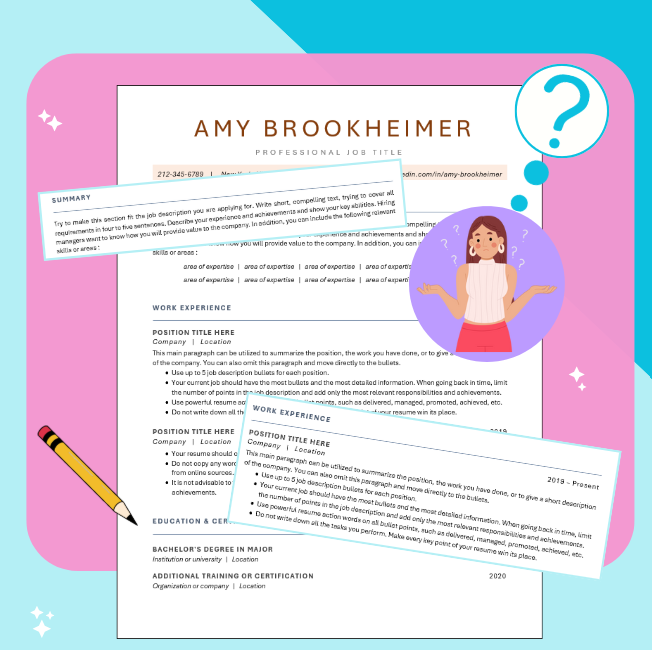
As a professional resume writer, I’ve written over 1,000 resume in the past 20 years. I make a living writing resumes for people who aren’t comfortable writing about themselves for a variety of reasons. However if you’re a decent writer, it’s not that difficult to create a resume that will showcase your skills, training, and experience and catch the eyes of hiring managers. Follow these steps to create a professional resume that you can use with confidence to pursue your next career opportunity. I’ll cover everything you need to know for how to write a resume, including each essential section, with writing and formatting tips that will help you stand out in a competitive job market.
Writing a resume in 2025 isn’t about using fancy buzzwords or squeezing your entire life story into a page. It’s about crafting a clean, compelling narrative that shows hiring managers you’re the answer to their prayers (or at least their job post). With job markets still evolving post-pandemic and AI screening tools lurking in applicant tracking systems (ATS), it’s more important than ever to get your resume right. I created this guide to help take the stress out of the process.

The TRUTH about ATS (Applicant Tracking Systems)
Many writers try to scare you with stories about how your resume is going to automatically be screened out by the ATS system evil; robot, and your resume will never be seen by a human, and you’ll never have a chance, and the sky is falling. Don’t fall for their scare tactics. The reality is that ATS systems are used by Human Resources to categorize resumes and match them with the requirements for each role. They are also used to store, track and mange all communications associated with the interview process. There is no way to “trick the ATS” but you do want to include keywords relevant to the requirements for each role you apply to.
Yes, You Can Write your Own Resume
Let’s be honest—hiring a professional resume writer can be a little scary. You’re trusting a stranger to understand your unique experience and career goals, and there are definitely advantages to writing your own resume: 1) You have complete control over the narrative, ensuring that your unique voice and personality shine through; 2) You’ll also develop a deeper understanding of your own professional value proposition, which becomes useful during interviews; and 3) The cost savings could a factor, as professional resume writers typically charge between $100-$800.
However, the DIY approach does come with challenges. Most job seekers lack the technical writing skills to optimize their resumes properly to get through Applicant Tracking Systems. Professional resume writers possess industry-specific knowledge about what hiring managers in different fields prioritize, along with insights into current trends and best practices that the average person might miss. They also bring an objective perspective that can identify strengths you might overlook or help you reframe weaknesses more strategically. Additionally, the time investment required to research, write, and refine an effective resume can be substantial – often 10-40 hours for a truly polished document. The decision ultimately depends on your budget, timeline, writing confidence, and the complexity of your career history.
Components of A Professional Resume
The standard reverse chronological format is appropriate for the majority of job seekers, so that’s the format we’ll use in our example. If you’re changing careers, transitioning from military to civilian role, or have a non-standard employment history, consider a functional or hybrid-style resume. I’ll cover those formats in a future blog post.
Your resume consists of 5 sections: Contact Information, Headline & Summary, Keywords, Work Experience, and Education, Training, Certification. Next I’ll walk you through creating each of these sections.
Start with a basic resume template you can find online, the template in this example is available for free download here.
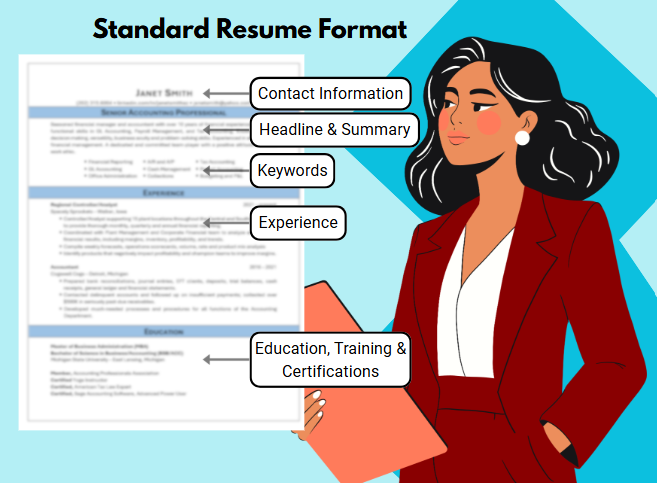
Contact Section
The Contact section should be the beginning of your resume-keep it simple and clutter free. Here’s what to include, and there is no need to include any other personal details such as age ,marital status etc.
- Your full name If you go by something other than your formal name, list it like this: Henry “Indiana” Jones, Emily “Emma” Stone, Thomas “Tom” Cruise
- One email and one phone number
- Your city and state (don’t include your address)
- Your professional email address
- A link to your LinkedIn professional profile, website, or portfolio
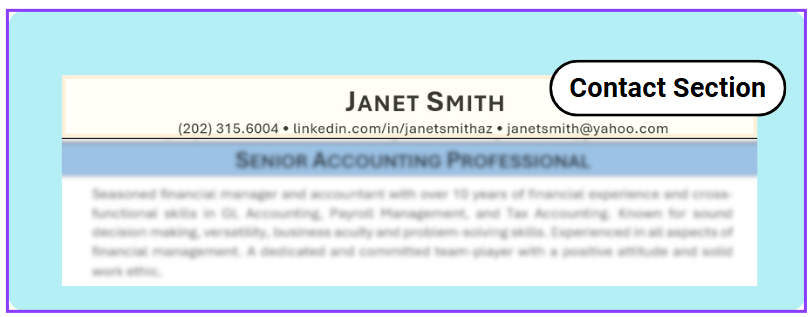
Pro Tip: Customize and shorten your unique LinkedIn link and include it, especially if your name is common (“linkedin.com/in/janet-a-johnson” is better than “linkedin.com/in/jasdfafajohnson-6864h289754” for example) Hiring Managers WILL look at your LinkedIn before deciding whether to contact you.

QUIZ TIME: Which of these email addresses are appropriate for a resume?
Answer: None of these are appropriate, especially aol.com, Boomer. Get a Gmail account based on your name, and keep it simple: margot.robbie99@gmail.com or mprobbie@gmail.com or mrobbiearizona@gmail.com are perfectamundo, says the Fonz
Headline and Summary
Your headline and summary should hook the hiring manager and attract them with your key skills, compelling them to read the rest of your resume. The headline is the title or role key position type that you’re applying to, no longer than 2-3 words. The summary should be 3-5 sentences that summarize your unique skills and experiences, using keywords from the job description where appropriate.
PRO TIP: Consider modifying the headline and summary to customize your resume for each role you’re applying to.
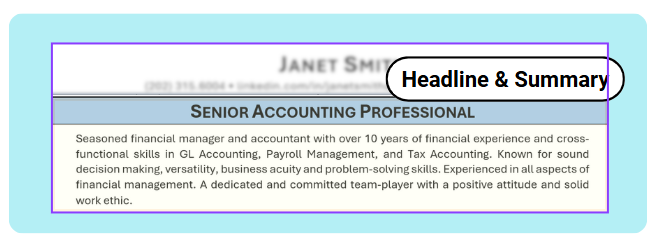
Keywords (These are important)
These days, resumes often get read by machines before humans, and look for specific keywords typically listed in the job posting requirements. Keywords should also be terms that are standard across the majority of job postings in your field. Sprinkle these relevant keywords throughout your resume (and cover letter). These might include:
- Job Titles (“Project Manager”)
- Skills (“Adobe Creative Suite”)
- Industry Jargon (“Agile methodologies”)
- Accomplishments (“30% Revenue Increase”)
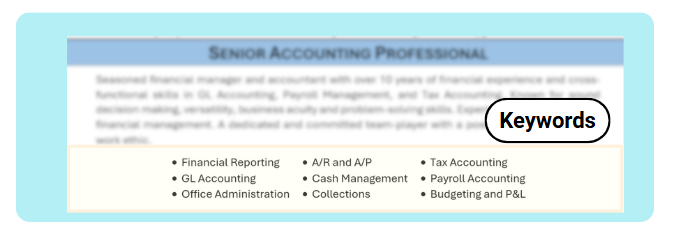
PRO TIP: Don’t just stuff keywords randomly—context matters. The more specific to the job posting, the better.
Experience (The Main Event)
In the Experience section, list your work history and highlight your accomplishments with specific metrics if possible, starting with your most recent job first. Your Job Title and dates of employment (years only, not months) should be most prominent, followed by the company name and city/state. Include a one-sentence overview of what the company does in italics right below the company name, but only do this for companies that are unknown. List jobs in reverse chronological order, including:
- Job Title
- Company Name & Location
- Dates of Employment
- 3–5 bullet points for each job
Bullet points should focus on your achievements, not just responsibilities. Instead of “Managed team projects,” try “Led cross-functional team of 6 to prepare and deliver product 3 weeks ahead of schedule, boosting client satisfaction by 25%.” instead of “Increased sales revenue” try “Increased sales revenue by 22% ($425,000) year over year, 2024 vs. 2023, 2023 vs. 2022”
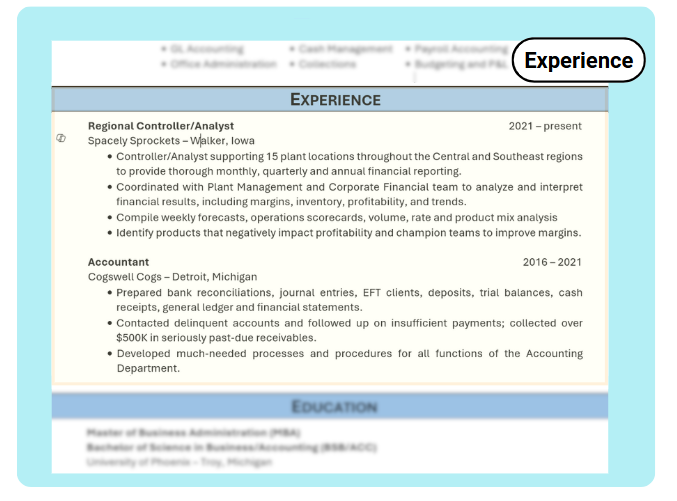
- List work experiences in reverse chronological order with the correct tense, past or present, and action verbs to describe your assets
- Go back 10-15 years work history at the most
- List your current role in present tense and previous roles in past tense
- List each employer’s name, job title, city, state and employment dates? (you don’t need months, just years
- Describe your best skills and accomplishments, the results you brought to projects, and highlights of skills that are most relevant to your target position
- Include as many relevant keywords from the job posting as possible
- Use 3-5 bullet points per role, ideally including 1-3 accomplishments or specific results, with quantifiable metrics
- Each bullet point should answer these questions: What did you do? How did you do it? Did it work? What was the result or impact?
Education, Training & Certifications
Unless you’re a recent grad, this section should come after your work experience. List each degree or certification in reverse chronological order including relevant continuing education, online learning, or other non-degree education or certifications
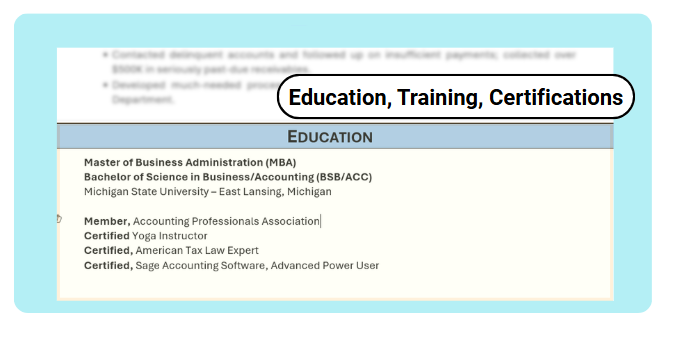
Volunteer and Interests
These sections are optional, but If you include this section, be sure that each activity is somewhat relevant to your target job role. However, it could be used as resume filler if your history and experience is limited. (Don’t get all judgey folks, its a resume, not a sworn legal testimony lol.) Grab that bag my friend, that’s the goal.
Consider including activities such as clubs, volunteer activities, leadership roles, community service, hobbies
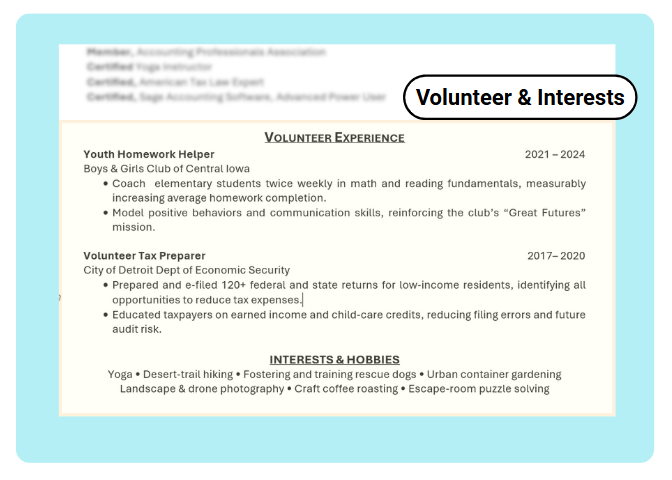
Important Guidelines
- Always write in the third-person, at a 10th grade reading comprehension level
- Remove soft skills like “hard-working, good communication, effective leader.” Instead, add information throughout your resume and cover letter that would let the reader conclude those things themself
- I don’t recommend including a picture because it might be an HR issue in large companies and the ATS doesn’t care what you look like and it takes up valuable real estate, but FINE if you absolutely must insist. Especially if you’re hot. (kidding, just wanted make sure you’re paying attention).
- Double-check for spelling, punctuation and grammar errors. Ask at least two of your most literate:) friends to review and comment
- Scrub your social media for anything that might be considered inappropriate or offensive
- Save your resume similar to this: “Margot Robbie Resume.2026.docx”?
- Send your resume in PDF format, unless specified otherwise of course. Otherwise, send via MS Word or Google Docs
- Need help with creating a stunning cover letter, customized for each role you’re applying to? Get Resume Rick’s Cover Letter Customization and Writing Guide, free on request by email

Thanks for reading, I hope you find this information useful. I’m Rick, a professional resume writer living in Phoenix. I’ve written over 1,000 resumes for all roles, including Sales and Marketing, Customer Service, Skilled Trades, Operations, Frontline Workers, Logistics, Business Development, Retail, General Managers, Financial Services, Administrative, Project Managers, Healthcare, Human Resources, IT, Engineering, Software, Mortgage and Real Estate, Teaching (plus many unusual roles, like Magician, Canine Therapist).
I also work with recent graduates, military personnel transitioning to civilian roles, and other career transitions or changes.
Here’s How I Can Help You:
1) FREE Resume evaluation. I’ll review your resume and tell you exactly what you need to do to make it great. With specifics and suggestions. Completely free. If your resume is already pretty good, I’ll tell you that–and I won’t try to upsell you:)
2) Hire me to write your custom resume and cover letter. LinkedIn too, if you like. 2-5 day turnaround, unlimited revisions, affordable pricing. I can also customize your resume and/or cover letter(s) for specific roles. Contact Me for Details.

